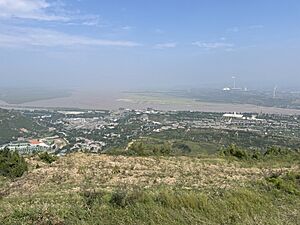Wei River facts for kids
The Wei River is a big river in central China. It flows through Gansu and Shaanxi provinces. It's the biggest river that flows into the Yellow River. The Wei River was very important for the start of Chinese civilization. Long ago, people called it Wei Shui, which means 'Wei water'.
The Wei River is about 818 kilometers (508 miles) long. It covers a large area of land, about 135,000 square kilometers (52,000 square miles), where all its water collects. Some of its main smaller rivers, called tributaries, include the Luo River, Jing River, Niutou River, Feng River, and the Chishui River. The Wei River flows mostly east for about 700 kilometers (435 miles). It joins the Yellow River at Tongguan County. Many important cities are along its path, like Tianshui, Baoji, Xianyang, Xi'an, and Weinan.
Contents
Where the Wei River Starts

The Wei River begins in the mountains of southern Weiyuan County in Gansu province. This county's name even means "Wei's source." The very start of its main part, the Qingyuan River, is less than 1.6 kilometers (1 mile) from another river that flows into the Yellow River.
The Wei River proper forms when the Qingyuan River joins two smaller rivers. Even though the Yellow River is close by at Lanzhou, the Wei River doesn't meet it there. This is because the Yellow River makes a sharp turn north. So, the Wei and Yellow Rivers don't meet until more than 2,000 kilometers (1,240 miles) later along the Yellow River's path.
After many other smaller rivers join it, the Wei River turns southeast. It flows through Wushan County and Gangu County. It then curves north of Tianshui, which is the second-largest city in Gansu. After picking up the Ji River, which flows through Tianshui, the Wei River enters the Mount Long area. It then becomes the main river in the Guanzhong Basin. Finally, it flows into the Yellow River near the border of Dali County and Tongguan County.
Weather in the Wei River Valley
The Wei River valley has a continental climate. This means it has hot summers and cool, dry winters. The area is located between the dry grasslands and deserts to the north and the forests of the Qingling mountains. Naturally, the land would have a mix of grasslands and forests. However, people have changed it a lot, and now it is mostly used for farming.
History of the Wei River
In Chinese mythology, a giant named Kua Fu tried to drink the Yellow River and the Wei River. He was very thirsty from chasing the Sun. The Wei River valley was one of the first places where Chinese civilization began. Important ancient Chinese capitals were built here, including those of the Zhou, Qin, Han, and Tang dynasties.
The area around the Wei River's source in Gansu, called Dingxi, has many Stone Age sites. These sites show that early cultures lived there. The Wei Valley was likely the first main center of Chinese civilization. It was also the place where China's first big irrigation systems were built. Some historians believe the Wei River is the ancient Jiang River. This river gave its name to the families of Shennong and the Yan emperor. These two legendary Chinese heroes are known for helping agriculture start in this area.
The Wei River's source was also important for the Northern Silk Road. This was because it was "China's natural gateway" to the west. The Chinese part of the Northern Silk Road connected Chang'an (the capital of China at the time) to the west. It went through Baoji, Tianshui (at the Wei's source), Lanzhou, Dunhuang, and the Wushao Ling Mountain. Then it looped north of the Taklamakan Desert on its way to Kashgar and routes into Parthia.
A picture of the Wei River Bridge (Weihe Qiao) was on the 5000-yuan note from 1953. This was part of the first series of Chinese money. It showed a train crossing the bridge.
In 2003, heavy rains caused a lot of flooding in September. This flood led to over 30 deaths. It also made more than 300,000 people temporarily leave their homes.
See also
- Guanzhong



